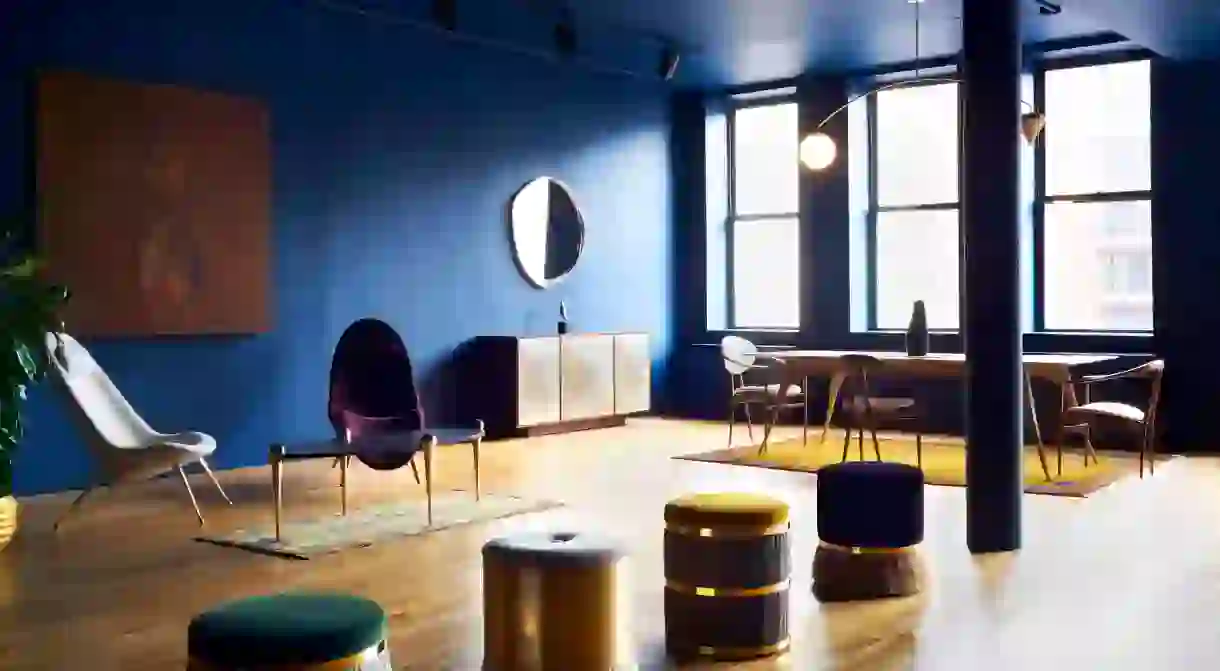Sublimely Chic Furniture Collection Debuts in NYC's Chinatown

Inspired by summers in Nantucket, the curves and contours of tumbled stones, and a matriarchal artist lineage, KONEKT brings hand-crafted, free-form furniture to Manhattan’s Chinatown.
Helena and Natasha Sultan first launched KONEKT in 2015. The mother-daughter design team wanted to create a sensory experience with furniture to create something a little sublime. The two women inherited an obsession with tumbled sea stones from their respective mother and grandmother, who drew inspiration from them when working on her sculptures and paintings. Like the stones on the shores of Nantucket, each piece of KONEKT’s collection is perfectly unique with its own texture and variety; the result is functional pieces of art.

Last month, KONEKT opened a new showroom in Chinatown to house their contemporary, sculptural furniture line, which stands out from the mass-produced, homogenized objects seen in big-box furniture stores.
Culture Trip reached out to the Sultans to discuss what it’s like to work as a mother-daughter team, what it means to create a sensory experience through design, and the value of using ancient (and generational) techniques in the creation process.
Culture Trip (CT): Is the location – New York City’s Chinatown – significant in any way?
KONEKT (K): Our brand is about engaging the senses and we wanted a location and space that lent itself to that vision. Manhattan’s Chinatown is incredibly vibrant and stimulating, so we feel our brand is right at home there.
CT: How do your furniture pieces “engage the senses”? Would you say you’re creating sensory experiences through furniture design?
K: Our furniture is tactile and is meant to be touched and physically experienced. We focus on using materials that have interesting textures and markings, and creating pieces that are sculptural in form. Our intention is to create a sensory experience; we want our clients to feel a need to touch a parchment sideboard, or to feel drawn to sit in the curves of a chair.

CT: If you could summarize your collection in five words, what would they be?
K: Tactile, sensual, sculptural, luxurious, and artisanal.
CT: How do you go about naming the pieces? Do you let the object speak to you after it’s completed or do you start with the name?
K: The name always comes last. Most of our pieces end up being named after whatever inspired them, whether that’s something from nature, an object or a person.

CT: You mention the collection “embraces the imperfection and randomness found in natural materials, as well as the juxtaposition of contrasting textures, markings, and finishes.” I can’t help but think of the wabi-sabi trend in relation to this. Would you say your collection embodies this aesthetic and tradition?
K: We like to think so; we’ve certainly drawn a great amount of inspiration from the concept and aesthetics of wabi-sabi.
CT: What techniques do you use to achieve your contemporary aesthetic?
K: We work with craftsmen whose skills were passed down from previous generations, so they combine their knowledge of techniques that have been reliable for centuries with the technologies available today.
For instance we have metal pieces that are made using sand casting, a technique which was used in ancient China, and then we have wood tables that are cut with CNC machines. Our designs are also influenced by vintage and antique design; the combination of the old and new in both areas feels very conducive to creating modern yet timeless pieces.

CT: What’s it like working as a mother-daughter team? Do you think the familial relationship facilities a new kind of creativity?
K: It’s pretty exciting working as a mother-daughter team, we share the same aesthetic so being able to create things together feels incredibly natural. Sometimes it feels like we’re one of those couples who are constantly finishing each other’s thoughts and sentences.
There’s a level of comfort that allows us to talk totally freely, which is hard to find outside of a familial relationship. I think this comfort is a huge part of our creative process, as we can bounce ideas off of each other with no fear of judgement or bruised egos.

CT: How do your aesthetics differ? And how do they complement each other?
K: We actually have very similar aesthetics, we’ve always had a shared taste in most visual things. Helena’s aesthetic can be a bit more refined while mine can be more unconventional, which I think really balances us out. Nothing ends up too polished or too weird.

CT: Do you each have a favorite item in the collection that you’d like to highlight?
K: Right now our favorite pieces are the Dionis Side Table and Sonya Dining Table, both from our Stone Collection. The collection is inspired by the curves and contours of stones tumbled by the ocean. An obsession with these kind of stones was passed down from our respective mother and grandmother, who creates stone sculptures and uses their textures and markings as inspiration for her oil paintings.














